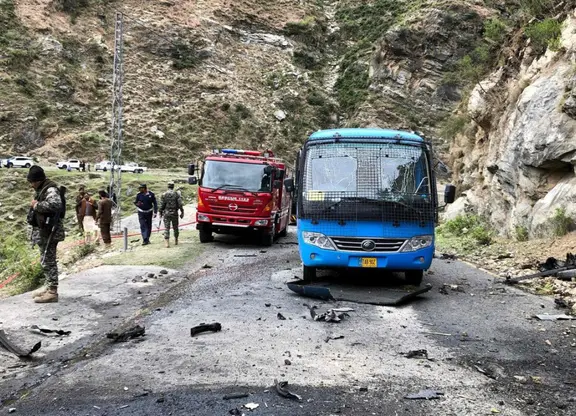INTRO: Bactrian camels are the last remaining wild camels on this planet, with only less than 900 living in the harsh deserts of China and Mongolia. Next we take you to a nature reserve in northwestern Gansu Province, to pay a visit to the critically endangered animal.
VO: Situated in the vast Kumtag Desert at the west end of Gansu Province, Annanba is one of the few habitats of Bactrian camels in China. A state-level reserve was established here in 2006 to protect the rare animals.
Over 100 Bactrian camels are estimated to live in the reserve, which cover a total area of 39.6 hectares.
Bactrian camels are the last remaining wild camels. The animal is listed as critically endangered by the International Union for Conservation of Nature.
Scientists believe that less than 900 Bactrian camels currently live in the harsh deserts of China and Mongolia, with around 420 to 450 in Gansu and the neighboring Xinjiang Uygur Autonomous Region.
(Inspection team leaving the office)
SOUNDBITE (CHINESE) HELATI, Head of Annanba Nature Reserve:
“Wang, keep an eye on the entrance. Don’t let any suspicious car get in the reserve.
VO: 42-year-old Helati, head of the administration office of Annanba Reserve, is going off on an inspection tour to visit the wild camels with his colleagues.
The inspection is scheduled once every month, and joined by zoologists and patrol guards. They have to drive over 100 kilometers in the desert to reach the animals’ habitats.
Zoologists will record the migration routes and the living conditions of the camels, while patrols will check on
suspicious vehicles and people
that might endanger the rare creatures.
After driving for almost three hours, they finally spotted the first camel on this trip.
(Chasing a wild camel)
VO: A Bactrian camel can run as fast as 80 kilometers per hour, and it can keep running for over 100 kilometers without rest. So it wasn’t easy for the inspection team to catch up with the animal.
The camels can adapt to harsh deserts where temperatures fluctuate wildly. Another remarkable trait of wild camels is that they can cry and do so to wash sand from their eyes.
Compared with domestic camels, Bactrian camels, which usually live in herds,have slenderer bodies, thinner legs and lower pyramidal humps, and are scared of human beings.
Their powerful noses can smell humans several kilometers away, helping them make fast escapes.
SOUNDBITE (CHINESE) HELATI, Head of Annanba Nature Reserve:
“Bactrian camel is a strong, sensitive and very smart wild animal. It can survive any harsh environment, for example, the Kumtag Desert, Lop Nor, and the northern slope of the Altun Mountain. It’s a miracle.
VO: However, a recent research shows that the animals are coming under threat from drought.
According to the research, due to global warming, the rainless Altun Mountain area has been suffering from even more deficit in precipitation, as snow and ice coverage on the mountain is shrinking as the underground water level is declining.
Many creeks and springs have dried up,and some wetland has become salinized. In addition, human encroachment has also aggravated water shortages.
To prevent the water from evaporating, the reserve built a 30-square-meter water pool at one of the wild camels’ migratory routes in 2010, and it provides drinking water to the camels and other wildlife nearby. Water is being channeled to the pool from a canyon far away.
Scientists have set up infrared cameras around the pool, to get closer shots of the timid animals.
SOUNDBITE (CHINESE) HUATTI, Patrol Guard:
“(How many camels did you see drinking from the pool?) One time we saw 27 of them. That was the largest herd we’ve seen, and there were 7 or 8 baby camels. ( So the animal’s productivity is not a problem?) Based on our inspection, the number (of Bactrian Camels) is increasing, and the range of their activities is expanding as well.
VO: Although the camels are now under state-level protection, they are often harassed by tourists, miners and stone collectors who break into the reserve, according to Helati.
SOUNDBITE (CHINESE) HELATI, Head of Annanba Nature Reserve:
“Some people like to take so-called ‘adventures’ in this area during holidays. They wonder around the desert and pick up rare stones. Some companies have come to build quarries and mines here. Those are the main human activities. No hunting activity has been reported so far. Once the wild camels feel intimidated, they’ll keep migrating, until they reach somewhere that feels safe to them.
VO: In order to preserve their wild nature, protecting the wild camels in their native desert habitat is still the major method undertaken by China, and artificial breeding is regarded as a last resort.
Helati said more pools would be built, and weather modification technologies would also be adopted to bring more rains, in effort to create a better living environment for the endangered camels.Enditem
 简体中文
简体中文





















